As Government notifies Consumer Protection Act 2019, consumers cheer the introduction of Class Action Suits
- • 95% believe that it will make redressal for misleading advertisement, defective products and deficient services easier
- • 51% in the last 3 years could not get resolution when they found they had a defective product
- • With CCPA having the powers to take up cases suo-moto based on consumer complaints, many issues affecting a group of consumers could find resolution
Indian Consumers welcome Class Action Suit mechanism via CP act 2019 to address product defects, service deficiencies and unfair trade practices

July 22, 2020, New Delhi: Earlier this week on July 20th, the Ministry of Consumer Affairs notified the Consumer Protection Act 2019 bringing in a long pending consumer reform. The act includes the establishment of the Central Consumer Protection Authority, CCPA which is empowered to conduct investigations into violation of consumer rights, order recall of unsafe goods and services as well take suo-moto complaints against brands where a class of consumers is impacted due to a defective product or deficient service.
Initiating action as a class comes as an additional mode of relief for the consumers which can be used along with individual complaints to address grievances, thereby empowering the consumers and giving them an option to carry out two parallel proceedings. Common examples of such complaints are a mobile phone model having an inherently defective battery, a service billed for but the delivery defaulted upon or consumers regularly presented with unsubstantiated and misleading advertisements, and where hundreds or thousands of consumers are impacted.
Class Action Suits are very common in countries like USA and one of the primary mechanisms for consumers to get redressal for overcharging, defective services, etc. The mechanism is typically a few consumers or plaintiffs finding and reporting an issue, followed by an outreach done to a broader consumer group via consumer platforms or class action counsel or both, roping in a larger group of consumers, estimating the loss and filing a suit against the defendant. In USA for instance, class actions are common where the allegations usually involve atleast 40 consumers who have been injured by the same defendant in the same way. In many cases, the defendants by law are bound to share contact details of the consumers impacted by that service for a broader outreach by the plaintiff group. Once the compensation is determined, the legal expenses and counsel fee are deducted and the leftover amount is shared amongst all the consumers in the proportion of the overcharging or injury. The class action allows the claims of all class members – whether they know they have been injured or not – to be resolved in a single proceeding through the efforts of the representative plaintiffs and appointed class counsel.
In India, on the LocalCircles online community in association with the Department of Consumer Affairs, hundreds of complaints are received each month where a large number of consumers are impacted. Cases include a defunc keyboard in a particular laptop model to a service provider not honouring warranty repair and from overcharging by private hospitals to misleading advertisement leading to severe damages for consumers.
To understand the extent of the issues faced by consumers and areas where the Class Action reform should focus first, LocalCircles conducted a survey to get consumer insights. The survey received more than 48,000 responses from consumers located in 270 districts across the country.
In the first question, 49% consumers said that they have had one or more inherently defective products in the last 3 years while 38% said they had never faced such an issue.
49% consumers say that they have had one or more inherently defective products in the last 3 years
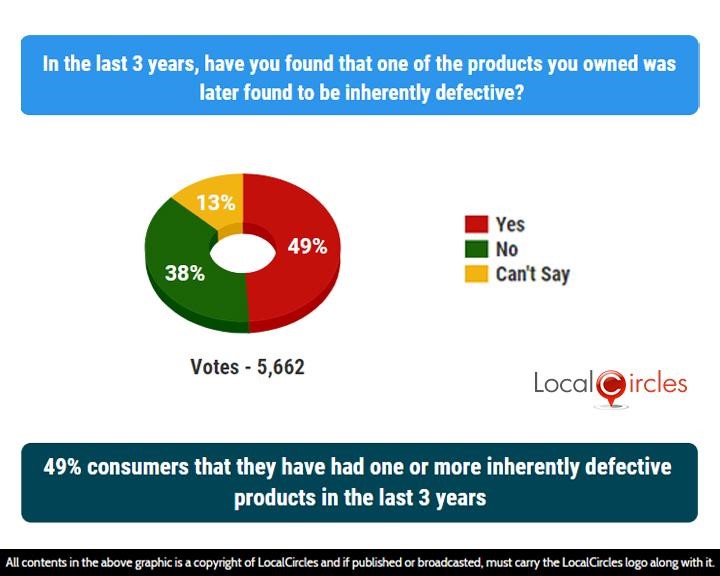
The next question asked consumers in the last 3 years, when they identified a defective product how did they get the issue resolved? 41% said they raised the issue with the brand and they fixed it. 21% said they raised the issue with the brand and they refused to fix it. 5% said they raised it with the brand, they refused but the consumer won in consumer court. 13% said they raised the issue with the brand, they refused to fix so the consumer created awareness about it on social media. 4% said they never raised the issue with the brand as they could not reach them and 8% said they never raised the issue with the brand and got it fixed locally.
51% consumers who had a defective product weren’t able to get assistance from the brand/manufacturer to fix it
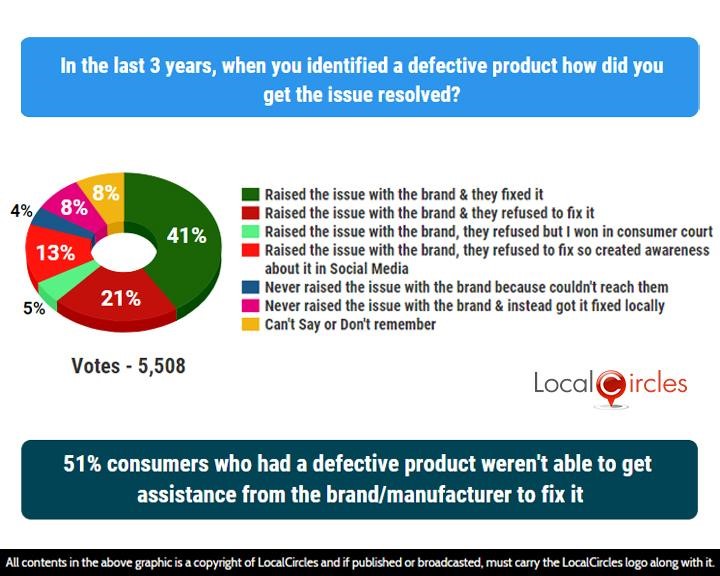
The next question asked consumers in the last 3 years, when they identified a defective service how did they get the issue resolved. 22% said they raised the issue with the service provider and they addressed it, 33% said they raised the issue with the service provider and they refused to address it, 5% said they raised the issue with the service provider, they refused but I won in consumer court, 14% said raised the issue with the service provider, they refused to address so created awareness about it in Social Media, 6% said they never raised the issue with the service provider and instead got it addressed locally, 14% said they haven't had any service issue in last 3 years, while 6% were unsure.
66% consumers who have major deficiency with a service weren’t able to get assistance from the service provider to address it
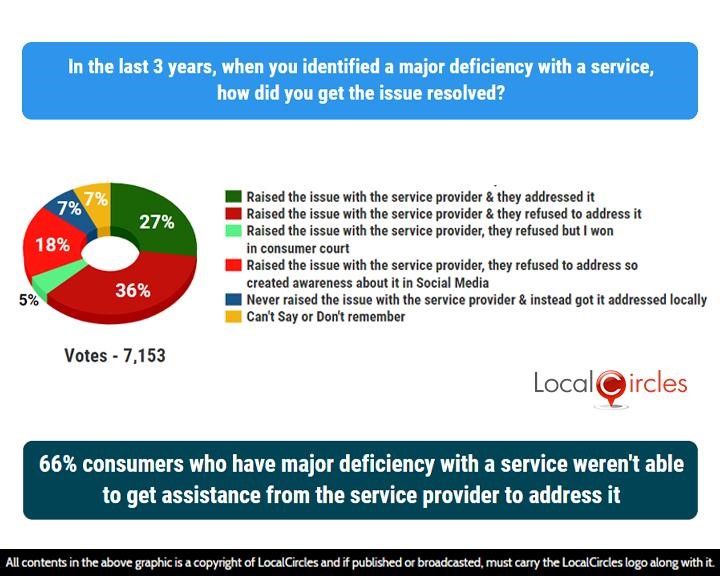
The next question asked consumers in the last 3 years, when they noticed a misleading advertisement or an unfair trade practice by a brand/service provider, how did they get the issue resolved. 14% said they raised the issue with the brand/service provider and they addressed it, 10% said they raised the issue with the brand/service provider and they refused to address it, 14% said they raised the issue with the brand/service provider, they refused to address so created awareness about it in Social Media, 38% said they never raised the issue with the brand/service provider, while 17% said they haven't had any such issues in last 3 years.
75% consumers who were subject to an unfair trade practice weren’t able to get assistance from the brand/service provider to address it
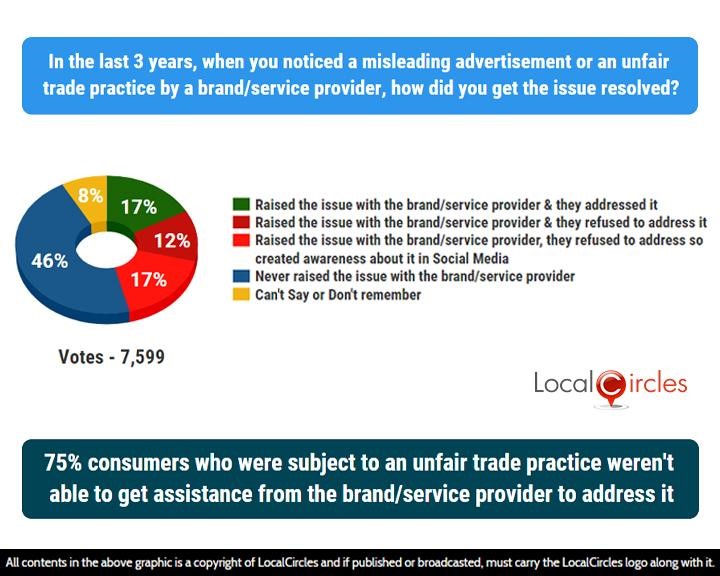
These three polls above are at the heart of the issue and indicate that most consumers currently suffer when they have a defective product in hand, a deficient service received or have been misled by an advertisement. Other than the lengthy process of consumer courts, till now there is no easy way to get redressal.
Other service areas where a large number of consumers face issues regularly are billing for mobile telephone services, DTH services etc. Consumers were also asked if they believed that a class action suit mechanism (where a large number of consumers facing the same issue with a defective product come together) will be instrumental in getting companies to accept returns of defective products. 95% consumers agreed with it.
95% consumers believe that a functional class action suit mechanism will be instrumental in getting companies to accept returns of defective products
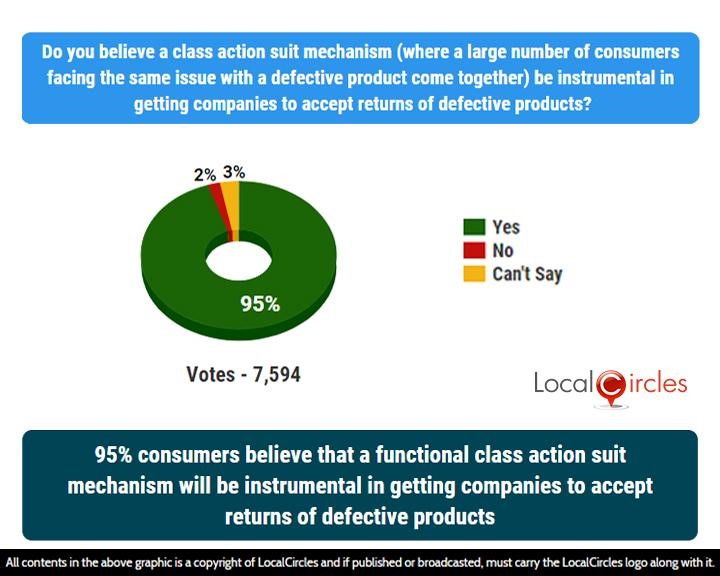
For instance, if a particular television model is found to have a faulty display, basis survey of other consumers owing that same model, it can be determined if a high majority is facing the same display issue. Accordingly, the brand can be approached by CCPA to initiate a product recall and if not done, a Class Action Suit framework can be utilised to take action against the brand or the company.
96% consumers also believe that a functional class action suit mechanism should be made applicable in case of a service contract and it should be made available in this scenario.
96% consumers believe that a functional class action suit mechanism should also be applicable in case of default on a service contract
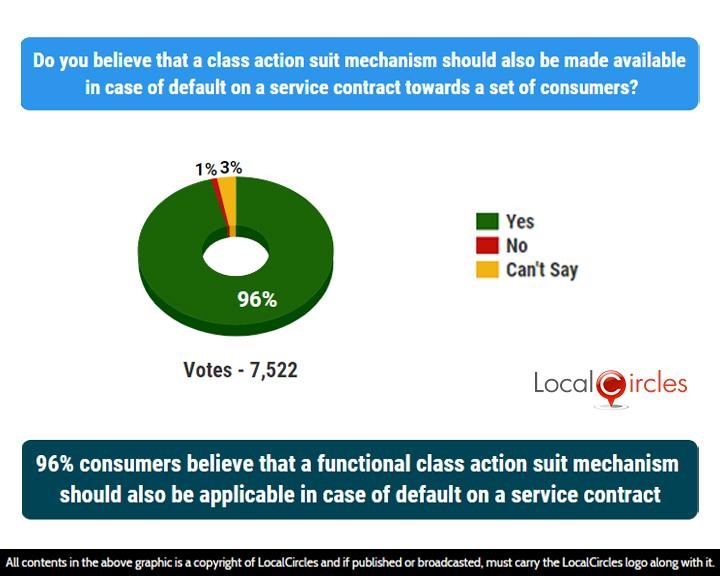
For example: If a major service deficiency was found with a mobile or DTH services provider to a large number of consumers and the services were billed at the full rate, the consumers collectively can now file a class action and demand compensation.
In the next question, 93% consumers said they believe that a functional class action suit mechanism should also be made applicable in case of a brand engaging in unfair trade practice or misleading advertisements.
93% consumers believe that a functional class action suit mechanism should also be applicable in case of a brand engaging in unfair trade practice or misleading advertisement
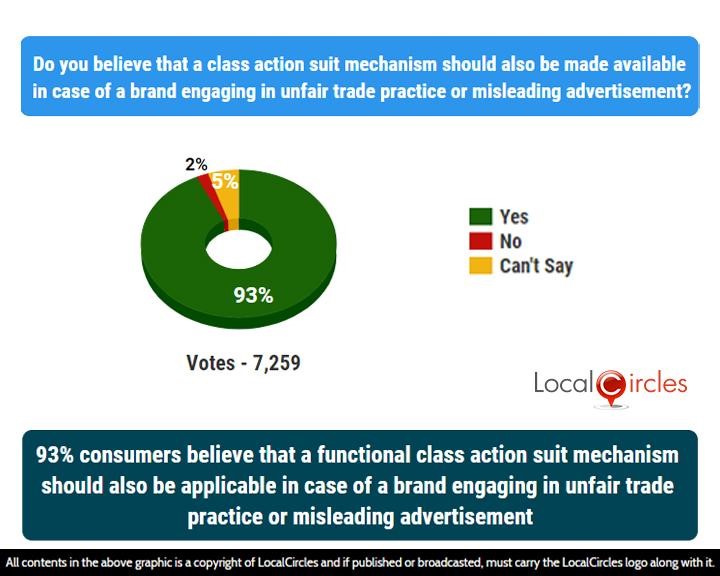
Misleading advertisements would include advertisements where false claims are being made by a brand which are then proven to be wrong. Be it an advertisement for an apartment investment promising assured returns, skin treatment that guarantees outcomes or nutrition products that claim fast physical and mental growth of children. Similarly, unfair trade practices include restaurants levying forced service charge on consumers or sellers on ecommerce portals displaying inflated MRP to show larger discounts to consumers.
The Consumer Protection Act 2019, under the CCPA, will also have a dedicated wing to inquire and investigate matters relating to consumer rights, unfair trade practices and misleading advertisements. According to the Consumer Protection Act 2019, the CCPA will have the powers to initiate a class action ‘Suo moto’. It will also have the ability to enforce recall, refund and/or return of products. With the Consumer Protection Act 2019 introducing the protection of consumers as a class, consumers hope that the cases of unfair trade practices, misleading ads will greatly reduce and commitment of brands towards resolving issues of defective products and service deficiencies will increase.
However, as we always say, in India implementation and enforcement is key. The success or failure of class action suits under Consumer Protection Act 2019 will be heavily dependent on how effectively is the CCPA structured and whether it takes Class Action cases on priority. With this report, the consumers have clearly identified the areas of priority as far as Class Action issues go.
LocalCircles will share the findings of this reports with the Department of Consumer Affairs so the consumers inputs receive due consideration as the CCPA structure and priorities are finalised.
Survey Demographics
48,000+ responses were received from consumers located in 270 districts of India. 64% respondents were men while 36% respondents were women. They survey was conducted via LocalCircles platform and all participants are validated citizens who had to be registered with LocalCircles to participate in this survey.
About LocalCircles
LocalCircles, India’s leading Community Social Media platform enables citizens and small businesses to escalate issues for policy and enforcement interventions and enables Government to make policies that are citizen and small business centric. LocalCircles is also India’s # 1 pollster on issues of governance, public and consumer interest. More about LocalCircles can be found on https://www.localcircles.com
Akshay Gupta - media@localcircles.com, +91-8585909866
All content in this report is a copyright of LocalCircles. Any reproduction or redistribution of the graphics or the data therein requires the LocalCircles logo to be carried along with it. In case any violation is observed LocalCircles reserves the right to take legal action.


